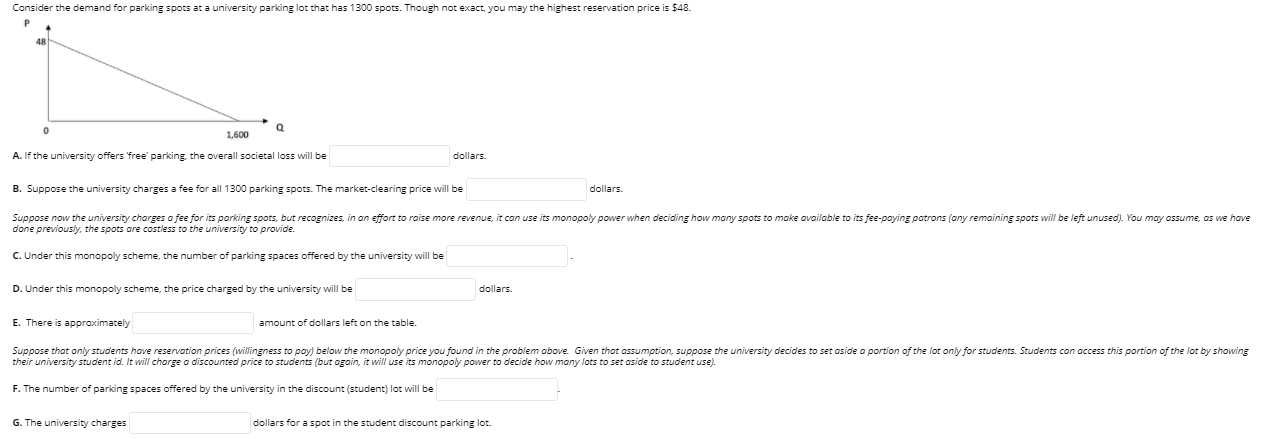Answered step by step
Verified Expert Solution
Question
1 Approved Answer
All i need are questions E, F, and G. I posted them all the questions if that helps though. Consider the demand for parking spots
All i need are questions E, F, and G. I posted them all the questions if that helps though.

Consider the demand for parking spots at a university parking lot that has 1300 spots. Though not exact, you may the highest reservation price is $48. P 48 0 1,600 A. If the university offers free parking the overall societal loss will be dollars. B. Suppose the university charges a fee for all 1300 parking spots. The market-clearing price will be dollars. Suppose now the university charges a fee for its parking spots, but recognizes, in an effort to raise more revenue, it can use its monopoly power when deciding how many spots to make available to its fee-paying patrons (any remaining spots will be left unused). You may assume, as we have done previously, the spots are costless to the university to provide C. Under this monopoly scheme the number of parking spaces offered by the university will be D. Under this monopoly scheme, the price charged by the university will be dollars. E. There is approximately amount of dollars left on the table Suppose that only students have reservation prices (willingness to pay) below the monopoly price you found in the problem above. Given that assumption, suppose the university decides to set aside a portion of the lot only for students. Students can access this portion of the lot by showing their university student id. It will charge a discounted price to students but again, it will use its monopoly power to decide how many lots to set aside to student use). F. The number of parking spaces offered by the university in the discount (student) lot will be G. The university charges dollars for a spot in the student discount parking lot. Consider the demand for parking spots at a university parking lot that has 1300 spots. Though not exact, you may the highest reservation price is $48. P 48 0 1,600 A. If the university offers free parking the overall societal loss will be dollars. B. Suppose the university charges a fee for all 1300 parking spots. The market-clearing price will be dollars. Suppose now the university charges a fee for its parking spots, but recognizes, in an effort to raise more revenue, it can use its monopoly power when deciding how many spots to make available to its fee-paying patrons (any remaining spots will be left unused). You may assume, as we have done previously, the spots are costless to the university to provide C. Under this monopoly scheme the number of parking spaces offered by the university will be D. Under this monopoly scheme, the price charged by the university will be dollars. E. There is approximately amount of dollars left on the table Suppose that only students have reservation prices (willingness to pay) below the monopoly price you found in the problem above. Given that assumption, suppose the university decides to set aside a portion of the lot only for students. Students can access this portion of the lot by showing their university student id. It will charge a discounted price to students but again, it will use its monopoly power to decide how many lots to set aside to student use). F. The number of parking spaces offered by the university in the discount (student) lot will be G. The university charges dollars for a spot in the student discount parking lot
Step by Step Solution
There are 3 Steps involved in it
Step: 1

Get Instant Access to Expert-Tailored Solutions
See step-by-step solutions with expert insights and AI powered tools for academic success
Step: 2

Step: 3

Ace Your Homework with AI
Get the answers you need in no time with our AI-driven, step-by-step assistance
Get Started


